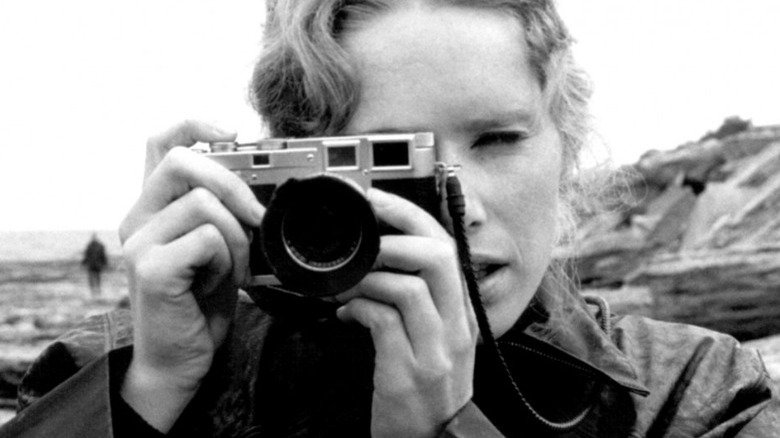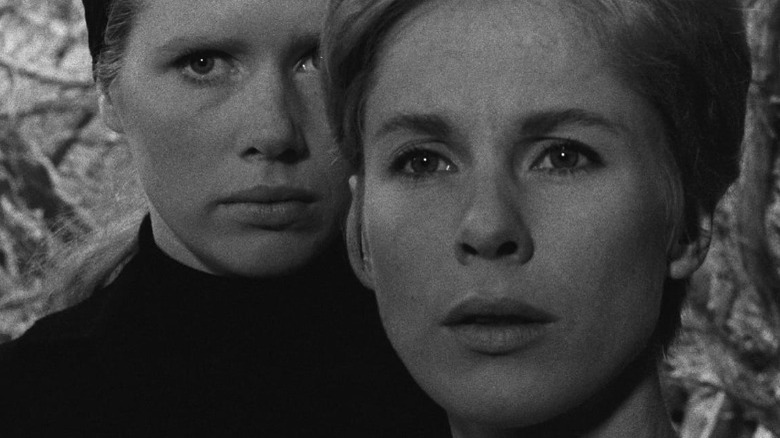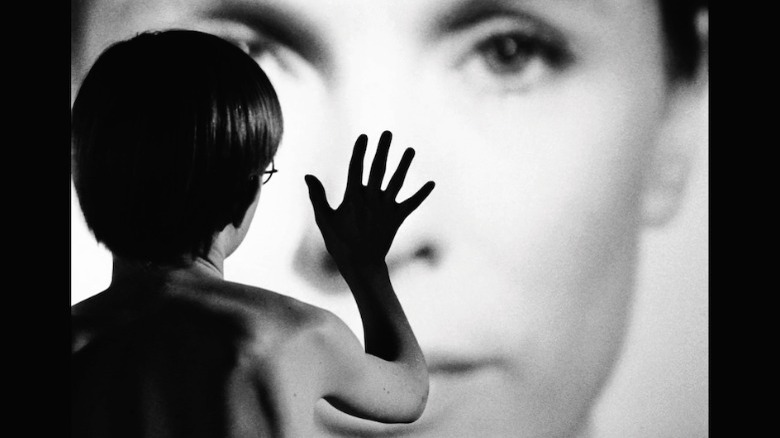Persona Ending Explained: Of Masks, Doubles, And The Delicate Nature Of Identity
In Ingmar Bergman's "Persona," two women — a nurse and a stage actor — are brought together by sheer circumstance, which forces them to reckon with essential truths about one another. The actor, Elisabet Vogler (Liv Ullmann), has inexplicably stopped speaking while performing "Elektra" onstage, and her silence appears to be self-imposed. With the intention of helping her speak again, the nurse, Alma (Bibi Andersson), takes Elisabet to a secluded cottage by the sea. What ensues is a fever dream of confessions both spiritual and lurid, and the birth of an intense love-hate relationship between Elisabet and Alma. What do these dreamlike, vivid exchanges in "Persona" mean? There are no easy answers, as Bergman's magnum opus defies expectations and interpretations — like all exceptional art, it accommodates a wide range of truths, which are often unsavory and contradictory.
Film historian Peter Cowie famously opined the following about "Persona:" everything one can say about the film may be contradicted, as the opposite will also be true. To some extent, Cowie is right, as there have been attempts to unravel "Persona" through a multitude of lenses, all of which remain valid. While some have applied the Jungian theory of "persona," which deals with the many social masks we wear to fulfill certain societal roles, others have analyzed it as a commentary on themes such as motherhood, revolution, sexuality, and the theatre as an artistic medium. Despite these valiant efforts, Bergman's "Persona" remains elusive, and perhaps for good reason. Some things cannot be explained or demystified, but only felt on a personal level that cannot be perfectly articulated.
Much like the rest of "Persona," the ending remains shrouded in coded allusions and buried truths. Although there are no sure-shot conclusions, here are some thematic strands that run through one of Bergman's most elusive films.
A vignette of beautiful, haunting images
"Persona" is undoubtedly stunning to behold, elevated by Sven Nykvist's electrifying cinematography that manages to add a dreamlike tint to both open and liminal spaces. Bergman sets up his shots in a purely experimental fashion, often breaking the fourth wall when one or both characters look directly into the camera, inviting viewers to be an active part of the film's reality. Owing to the nature of the narrative, and Bergman's fascination with faces, close-ups are used liberally throughout, notably during Alma's monologues and the final confrontation between the two women. All of these factors, when combined, produce a synesthesia of haunting imagery that lies somewhere between the real and imagined.
The seaside cottage, which is an intimate, secluded space cut off from the rest of the world, acts as a parallel world filled with possibilities. There, Alma and Elisabet start merging into one another, to the point that their trajectories — although wildly different — echo and mirror one another. After a certain point, it becomes unclear where Elisabet starts and Alma ends, and vice versa, although the catalyst behind this enmeshing is crystal clear.
Elisabet, through her self-imposed muteness, sheds every role expected of her: she no longer has to wear masks when she acts on stage, or pretend to be a doting mother for a child she secretly abhors. On the other hand, Alma perceives Elisabet as her sole confidant and mirror, which leads to her recounting a salacious orgy and subsequent abortion that still elicits shame and guilt. This displacement of anger, which she directs at the mute other, culminates in the boiling water scene, causing Elisabet to momentarily break her vow of silence. As familiarity and contempt escalate, the two women caress in a defining, magnetic scene, resembling two halves of a whole.
To double, or not to double
An abiding interpretation of the dynamic shared between Elisabet and Alma is that they represent two personas within the same soul, highlighting the duality of humankind. This is a sound interpretation, which can be fleshed out further when one applies the Jungian concept of persona. The enmeshing of Elisabet and Alma might be the natural outcome of discarding socially-constructed roles and embracing core impulses that can often be unpleasant to navigate — including ugly realizations about the self, the other, and our relation to the world at large. Along with these feelings of unease come moments of stark honesty, as epitomized in the scene where Alma recounts Elisabet's story.
Elisabet's refusal to speak is not only an artist's declaration of despair but a blaring rejection of the expected roles of motherhood she is expected to fulfill. In this case, her silence speaks volumes. In stark contrast, Alma's constant need to engage, verbalize and dramatize her innermost emotions reveals the chasm of loneliness inside her. Elisabet's unspoken willingness to listen to Alma makes the nurse feel heard and seen for the first time, but this newfound respite is a double-edged sword. Elisabet is also a reminder of Alma's past, wherein the latter was able to do what the actor had desperately hoped: successfully shed off the shroud of motherhood in favor of pursuing what her soul desires.
This inexplicable mirroring or doubling leads to the loss and displacement of identity when Mr. Vogler mistakes Alma for his wife and sleeps with her. This sequence is especially dreamlike as if it takes place at the threshold of the subconscious, never clearly addressed again, treated as one would treat a half-forgotten psychological impulse. Identity is a mutable, elusive construct in Bergman's world.
The portrait of an artist as an anguished woman
Elisabet, a stage actor, needs to don masks/personas to embody characters, which involve a negation of the self. However, can an artist ever shed their seemingly endless personas and truly be themselves in the face of worldly expectations? Bergman explores this theme in vivid and heartbreaking detail in his surrealistic "Hour of the Wolf," wherein the price of being an artist is complete self-effacement and ridicule in favor of fulfilling expected roles. Elisabet, while assuming the role of Elektra, has decided to shun others from her core self. In the process, she has willingly secluded herself from worldly expectations and scrutiny and has decided to "study" Alma instead, which triggers the role reversal.
As the personal is the political and artists cannot exist in a philosophical vacuum, Elisabet interacts with real-world incidents of horror and revolt, reactions to which can never be meaningful enough. A memorable scene is her reaction to Quảng Đức's self-immolation during the Vietnam war, which is a silent yet vocal act of rebellion. In contrast, Elisabet's mute revolt, although meaningful on a personal level, does little to nourish or justify her role as an artist. This persona of retreating from the world is her armor against artistic accountability.
Elisabet, a tortured artist who refuses to conform to the expectations of motherhood, deliberately others herself from everyone, including her own child. This circles back to the opening image of the film, where a child inside a morgue reaches out to a projected image of a woman who looks like Elisabet/Alma. There's an attempt to reach out, to understand, but a separation exists between who she truly is and the various roles she assumes.
No one can truly know or perceive her, and perhaps she likes it best when she's unknowable.



